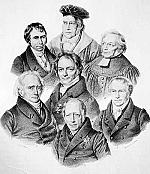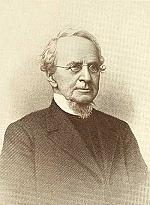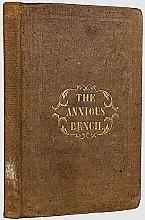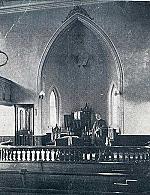Uniting law and gospel
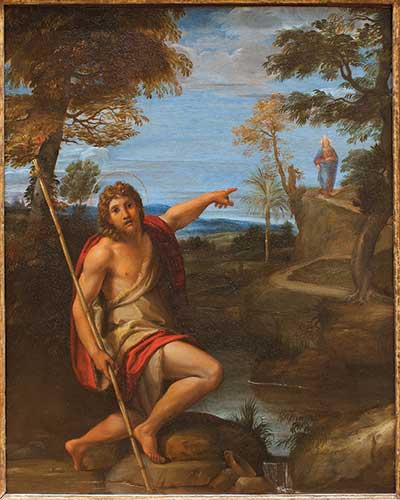
[Annibale Carracci, St John the Baptist Bearing Witness, c. 1600. Oil on Copper—Gift of Fabrizio Moretti and Adam Williams, in honor of Everett Fahy, 2009 / Metropolitan Museum of Art]
In The Principle of Protestantism (1845), Philip Schaff argues, through the symbolic examples of Jesus’s closest disciples and Paul the apostle, that the inevitable end of Protestantism and Catholicism is an ecumenical communion.
It is an interesting and beautiful thought, (to be felt indeed only by those who have some sense for the philosophy of Church history) by which the three most conspicuous apostles, PETER, PAUL, and JOHN are made to stand as the representatives in character of three great stages of development, through which the Church is to be carried to its final consummation. We meet the idea even among some of the old theologians. . . .
The Lord chose three favorite disciples, who are to be regarded as types at the same time of as many stages of development for the Church. Peter, the apostle of the Father, the New Testament Moses, or the representative of the principle of authority and law, answers in his personality and form of doctrine to the first stadium [stage] of Church history, the period of Catholicism, flowing over in the end to popery itself. Paul, the apostle of the Son, the New Testament Elias, the representative of the principle of movement, and of the free justifying power of faith, is the type of Protestantism.
Both stages, separately taken, are one-sided and incomplete. The principles of authority and freedom, law and gospel, hope and faith, must at last become united. The Roman Catholic Church, it is true, has like Peter denied her Lord by a threefold gradation in the way of apostasy; but she will one day yet go out and weep bitterly. Then will the Lord turn towards her with a look of compassion, and restore her again to confidence and trust.
IN THE SPIRIT OF JOHN THE EVANGELIST
This will be, at the same time, the epoch of the final reconciliation of both communions. So united, they will form the ideal Church, whose type is exhibited to us in the disciple that lay on Jesus’s bosom, the apostle of the Holy Ghost, the apostle of that love which shall never fail, the law of freedom made perfect and complete in the gospel. To him corresponds, under the old economy, John the Baptist, in whose person the rigor of the law and consolation of prophecy are united. As he immediately preceded the first appearance of Christ, like the dawn of morning, so also the revivification of the spirit of John the evangelist, in the Church, will open the way directly for his second coming, to establish the Church absolute and triumphant, in which law and freedom shall both be perfect in one, and the results of all previous development appear conserved as the constituent elements of a higher and more glorious state. To this refers the mystical sense of Christ’s word, John 21:22, where he speaks enigmatically of John’s tarrying till his second coming.
HOPE FOR THE NEW WORLD
May the Nineteenth Century, by a magnificent UNION, consummate the ever memorable Reformation of the sixteenth! May the New World, enwombing the life spirit of almost every nation of the Old, prove the birth soil of this new era for the Church! As the distractions of Protestantism have been most painfully experienced here, so here also may the glorious work of bringing all the scattered members of Christ’s body into true catholic union be carried forward with the greatest zeal and soonest crowned with the great festival of reconciliation, transmitting its blessings, in grateful love, to the world we honor and love as our general fatherland.
By Philip Schaff
[Christian History originally published this article in Christian History Issue #155 in 2025]
Philip SchaffNext articles
Christian History timeline: the Mercersburg movement
Chronology of Mercersburg theological movement
Anne T. ThayerRevival, rightly understood?
John Williamson Nevin and “New Measures” revivalism
John Williamson NevinMercersburg’s “worship war”
Crafting a new liturgy for the German Reformed Church created conflict, but also a lasting legacy
Walter L. TaylorSupport us
Christian History Institute (CHI) is a non-profit Pennsylvania corporation founded in 1982. Your donations support the continuation of this ministry
Donate



